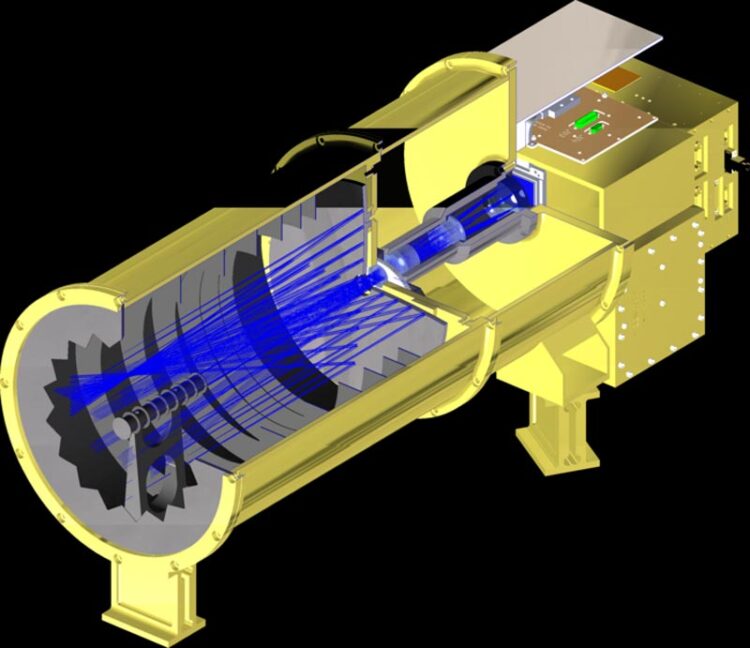Development of a next generation NOAA coronagraph

SwRI used internal funding to develop SwSCOR’s three-stage lens system mounted behind a single-pylon external occulter to minimize distortion across the field of view. A polarizer wheel is placed in front of the first lens. The current Phase A study will study options for the external occulter.
Credit: Southwest Research Institute
Short, externally occulted Space Weather Solar Coronagraph features novel 1.5-stage occultation scheme.
NASA has selected Southwest Research Institute for a Phase A study to develop SwRI’s Space Weather Solar Coronagraph (SwSCOR) on behalf of the National Oceanic and Atmospheric Administration (NOAA). NOAA’s Space Weather Next Program is charged with providing critical data for its space weather prediction center. SwRI is one of five organizations developing a definition-phase study to produce the next-generation NOAA L1 Series COR instrument to detect and characterize Earth-directed coronal mass ejections (CMEs).
CMEs are huge bursts of coronal plasma threaded with intense magnetic fields ejected from the Sun over the course of several hours. CMEs arriving at Earth can generate geomagnetic storms, which can cause anomalies in and disruptions to modern conveniences such as electronic grids and GPS systems. Coronagraphs are instruments that block out light emitted by the Sun’s surface so that its outer atmosphere, or corona, can be observed.
“SwSCOR is a short, externally occulted coronagraph with a novel 1.5-stage occultation scheme that enables darker, wider-field imaging than a single multi-disk occulter alone,” said SwRI’s Dr. Craig DeForest, who is leading the study. “Its Arago spot suppressor redirects the major source of diffracted stray light — the Arago spot — formed by the occulter itself. This design enables imaging closer to and/or farther from the Sun than comparably sized instruments with conventional occultation.”
Stray light is the largest challenge of coronagraph design. Coronal structures a few degrees away from the Sun are a billion times fainter than the Sun itself. Diffraction injects stray light into the optics as sunlight scatters around the occulter in front of the instrument. Multi-disk occulters cut stray light by many orders of magnitude in the current generation of single-stage coronagraphs. Adding more disks yields more occultation but tightens the machining or assembly tolerances.
“SwRI is investigating several novel occulter designs,” DeForest said. “Preliminary laboratory experiments with our latest prototype indicate a more than 10-fold improvement over similar-geometry multi-disk designs in use today, while improving manufacturability and alignment tolerances.”
SwRI designed SwSCOR using internal funding, incorporating heritage processes and facilities from the development of the Polarimeter to Unify the Corona and Heliosphere mission’s Wide-Field Imager (PUNCH/WFI). DeForest is the principal investigator of PUNCH, a NASA Small Explorer (SMEX) mission set to launch in 2025, which is designed to better understand how the mass and energy of the Sun’s corona become the solar wind that fills the solar system.
“We prototyped and tested key elements of SwSCOR in SwRI’s stray light cleanroom facility,” DeForest said. “It will directly measure the 3D trajectory of halo CMEs, eliminating the strongest ambiguity in arrival time forecasting: confusion between wide, slow CMEs and narrow, fast CMEs.”
For more information, visit https://www.swri.org/heliophysics.
Media Contacts
Cecilia Novak
Southwest Research Institute
cecilia.novak@swri.org
Deb Schmid
Southwest Research Institute
dschmid@swri.org
Office: 210-522-2254
All latest news from the category: Physics and Astronomy
This area deals with the fundamental laws and building blocks of nature and how they interact, the properties and the behavior of matter, and research into space and time and their structures.
innovations-report provides in-depth reports and articles on subjects such as astrophysics, laser technologies, nuclear, quantum, particle and solid-state physics, nanotechnologies, planetary research and findings (Mars, Venus) and developments related to the Hubble Telescope.
Newest articles

High-energy-density aqueous battery based on halogen multi-electron transfer
Traditional non-aqueous lithium-ion batteries have a high energy density, but their safety is compromised due to the flammable organic electrolytes they utilize. Aqueous batteries use water as the solvent for…

First-ever combined heart pump and pig kidney transplant
…gives new hope to patient with terminal illness. Surgeons at NYU Langone Health performed the first-ever combined mechanical heart pump and gene-edited pig kidney transplant surgery in a 54-year-old woman…

Biophysics: Testing how well biomarkers work
LMU researchers have developed a method to determine how reliably target proteins can be labeled using super-resolution fluorescence microscopy. Modern microscopy techniques make it possible to examine the inner workings…





















